Shaheed Bhagat Singh was a Brave Indian freedom fighter , great son of Mother India considered to be one of the most influential revolutionaries of the Indian independence movement. He was born on 28 September 1907 & Martyred on 23 March 1931. He is often referred to as Shaheed Bhagat Singh (the word shaheed meaning ‘martyr’)
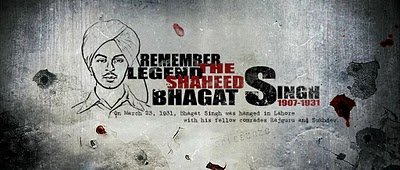
Born to a Sikh Jat family which had earlier been involved in revolutionary activities against the British Raj, Singh, as a teenager, became an atheist and had studied European revolutionary movements. He also became attracted to anarchism and marxist ideologies. He became involved in numerous revolutionary organizations. He quickly rose through the ranks of the Hindustan Republican Association (HRA) and became one of its leaders, and was influencial in changing its name to the Hindustan Socialist Republican Association (HSRA), which emphasises his socialist outlook. Singh gained support when he underwent a 41-day[13] fast in jail, demanding equal rights for Indian and British political prisoners.He was hanged for shooting a police officer in response to a police lathi charge leading to the demise of veteran freedom fighter Lala Lajpat Rai. His legacy prompted youths in India to begin fighting for Indian independence and contributed to the rise of socialism in India.
Bhagat Singh’s Family Background & Childhood
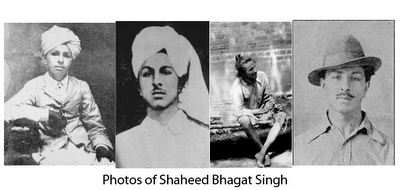
Bhagat Singh was born into a Sandhu Jatt family to Sardar Kishan Singh Sandhu and Sardarni Vidyavati Kaur in a village in the Lyallpur district of Punjab in modern-day Pakistan. Lyallpur is now know as Faisalabad. His ancestral village is the Khatkar Kalan village near Banga town in Nawanshahr District of Punjab.The District has recently been renamed as Shaheed Bhagat Singh Nagar. Singh’s given name of Bhagat means “devotee”, and he was nicknamed “Bhaganwala” by his grandmother, meaning “The lucky one”. He came from a patriotic Jatt Sikh family, some of whom had participated in movements supporting the independence of India and others who had served in Maharaja Ranjit Singh’s army. His grandfather, Arjun Singh, was a follower of Swami Dayananda Saraswati’s Hindu reformist movement, Arya Samaj, which would carry a heavy influence on Singh. His uncles, Ajit Singh and Swaran Singh, as well as his father were members of the Ghadar Party, led by Kartar Singh Sarabha Grewal and Har Dayal. Ajit Singh was forced to flee to Persia because of pending cases against him while Swaran Singh died in 1910 at his home after releasing from Borstle Jail, Lahore.
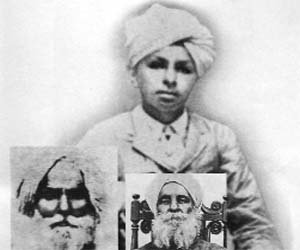
Unlike many Sikhs his age, Bhagat Singh did not attend Khalsa High School in Lahore, because his grandfather did not approve of the school officials’ loyalism to the British authorities. Instead, his father enrolled him in Dayanand Anglo Vedic High School, an Arya Samajist school. At age 13, Singh began to follow Mahatma Gandhi’s Non-Cooperation Movement. At this point he had openly defied the British and had followed Gandhi’s wishes by burning his government-school books and any British-imported clothing. Following Gandhi’s withdrawal of the movement after the violent murders of policemen by villagers from Chauri Chaura, Uttar Pradesh, Singh, disgruntled with Gandhi’s nonviolence action, joined the Young Revolutionary Movement and began advocating a violent movement against the British.
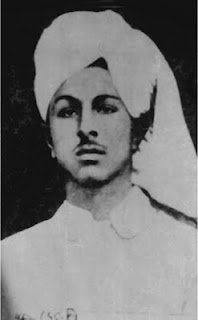
In 1923, Bhagat singh famously won an essay competition set by the Punjab Hindi Sahitya Sammelan. This grabbed the attention of members of the Punjab Hindi Sahitya Sammelan including its General Secretary Professor Bhim Sen Vidyalankar. At this age, he quoted famous Punjabi literature and discussed the Problems of the Punjab. He read a lot of poetry and literature which was written by Punjabi writers and his favourite poet was Allama Iqbal from Sialkot.
In his teenage years, Bhagat Singh started studying at the National College in Lahore, but ran away from home to escape early marriage, and became a member of the organisation Naujawan Bharat Sabha (“Youth Society of India”). In the Naujawan Bharat Sabha, Singh and his fellow revolutionaries grew popular amongst the youth. He also joined the Hindustan Republican Association through introduction by history teacher, Professor Vidyalankar, which had prominent leaders like Ram Prasad Bismil, Chandrashekhar Azad and Ashfaqulla Khan. It is believed that he went to Kanpur to attempt free Kakori train robbery prisoners from the jail, but returned to Lahore for unknown reasons. On the day of Dasara in October 1926, a bomb was blasted in Lahore, and Bhagat Singh was arrested for his alleged involvement in this Dasara Bomb Case in 29 May 1927, and was released on a bail of Rs.60,000 after about five weeks of his arrest. He wrote for and edited Urdu and Punjabi newspapers published from Amritsar. In September 1928, a meeting of various revolutionaries from across India was called at Delhi under the banner of the Kirti Kissan Party. Bhagat Singh was the secretary of the meet. His later revolutionary activities were carried out as a leader of this association.
Lala Lajpat Rai’s death and the Saunders murder
The British government created a commission under Sir John Simon to report on the current political situation in India in 1928. The Indian political parties boycotted the commission because it did not include a single Indian as its member and it was met with protests all over the country. When the commission visited Lahore on 30 October 1928, Lala Lajpat Rai led the protest against Simon Commission in a silent non-violent march, but the police responded with violence. Lala Lajpat Rai was beaten with lathis at the chest. He later succumbed to his injuries. Bhagat Singh, who was an eyewitness to this event, vowed to take revenge. He joined with other revolutionaries, Shivaram Rajguru, Sukhdev Thapar, Jai Gopal and Chandrashekhar Azad, in a plot to kill the Superintendent of police, J. A. Scott. Jai Gopal was supposed to identify the chief and signal for Singh to shoot. However, in a case of mistaken identity, Gopal signalled Singh on the appearance of John P. Saunders, an Assistant Superintendent of Police. J.P. Saunders in his early twenties, still a probationer, while leaving the District Police Headquarters at about 4:15 p.m. on December 17, 28 was mistaken as Scott and shot by Rajguru and Bhagat Singh. Head Constable Chanan Singh was also killed when he came to his help.
Bhagat Singh’s Dramatic escape
After killing Saunders, they escaped through the D.A.V. College entrance, on the other side of the road. Head Constable Chanan Singh who chased them was fatally injured by Chandrashekhar Azad’s covering fire. They then fled on bicycles to the prearranged places of safety. The police launched a massive search operation to nab the culprits and blocked all exits and entrances. The police sealed all roads from the city; the CID kept a watch at the railway stations and all young men leaving Lahore were carefully scrutinized. They kept themselves underground for the next two days.
Sukhdev called at Mrs Durga Devi Vohra after 10 p.m. on December 19, 1928. She agreed to help them out. It was settled that they would catch the train leaving Lahore for Howrah en route Bathinda the next morning at 6:10. That train was chosen because they could leave in the early hours before the arrival of CID picket. Bhagat Singh in Western dress carrying the sleeping infant, Durga Bhabi in her most impressive attire and Rajguru shuffling under luggage, left the house at about 5 a.m. long before the CID arrived. On reaching the station, Bhagat Singh keeping his facial profile reasonably covered on one side with a slightly raised collar of the overcoat and on the other by the sleeping infant, purchased two tickets, a joint second class Christmas return ticket and a third class one for the servant, for Cawnpur. They walked side by side into the railway station with Rajguru carrying the luggage behind in a servile manner. Both men carried concealed loaded revolvers with them for facing any untoward incident, because police parties in uniform as well as in civil clothes were watching carefully all departures from Lahore. An impressively respectable young couple carrying a child, Western style dress and to top it all, a joint second class Christmas return ticket cast a spell over the police and they boarded the train without causing any suspicion. To avoid recognition, Bhagat Singh shaved his beard and cut his hair, a violation of the sacred tenets of Sikhism.
Breaking journey at Cawnpur they went to Lucknow, as the CID at Howrah kept a close watch on passengers coming directly from Lahore. At Lucknow Rajguru parted company and left for Varanasi. Bhagat Singh, Durga Bhabhi and the infant went to Howrah, and moved to Shushila Didi’s place. Durga Devi went back to Lahore a few days later.
Bomb in the assembly
In the face of actions by the revolutionaries, the British government enacted the Defence of India Act to give more power to the police. The purpose of the Act was to combat revolutionaries like Bhagat Singh.[36] However, the Act was then passed under the ordinance that claimed that it was in the best interest of the public. In response to this act, the Hindustan Socialist Republican Association planned to explode a bomb in the Central Legislative Assembly where the ordinance was going to be passed. This idea was originated by Bhagat Singh, who was influenced by a similar bombing by a martyr anarchist Auguste Vaillant in the French Assembly. It was decided that Bhagat Singh should go to Russia, while Batukeshwar Dutt should carry on the bombing with Sukhdev. Sukhdev then forced Bhagat Singh to call for another meeting and here it was decided, against the initial agreement, that Batukeshwar Dutt and Bhagat Singh would carry on the bombing. Bhagat Singh also disapproved that the two should be escorted after the bombing by the rest of the party.
On 8 April 1929, Singh and Dutt threw a bomb onto the corridors of the assembly and shouted “Inquilab Zindabad!” (“Long Live the Revolution!”). This was followed by a shower of leaflets stating that it takes a loud voice to make the deaf hear.
The bomb neither killed nor injured anyone; Singh and Dutt claimed that this was deliberate on their part, a claim substantiated both by British forensics investigators who found that the bomb was not powerful enough to cause injury, and by the fact that the bomb was thrown away from people. Singh and Dutt gave themselves up for arrest after the bomb. Bhagat Singh and Batukeshwar Dutt were sentenced to ‘Transportation for Life’ for the bombing on 12 June 1929.
Bhagat Singh Trial and execution
The story of the Trial of Bhagat Singh is as much a story of revolution in India as the system of law and justice under the British rule. Bhagat Singh’s trial is an important event in the Indian history because it defied the fundamental doctrine of criminal jurisprudence. The trial was held ex-parte in breach of the principles of natural justice according to which No man shall be condemned unless he is given a hearing.
On April 8, 1929, Bhagat Singh and B.K. Dutt threw a bomb in the Central Legislative Assembly to make the deaf hear. As intended, nobody was hurt by the low intensity explosion as Bhagat Singh had aimed the bomb carefully, to land away from the seated members, on the floor. Bhagat Singh and B.K.Dutt let themselves be arrested, even when they could have escaped, to use their court appearances as a forum for revolutionary propaganda to advocate the revolutionaries’ point of view and, in the process, rekindle patriotic sentiments in the hearts of the people. Bhagat Singh surrendered his automatic pistol, the same one he had used to pump bullets into Saunder’s body, knowing fully well that the pistol would be the highest proof of his involvement in the Saunders’ case.
On 15 April 1929, the ‘Lahore Bomb Factory’ was discovered by the Lahore police, and the other members of HSRA were arrested, out of which 7 turned informants, helping the police to connect Bhagat Singh in the murder of J. P. Saunders.Bhagat Singh, Rajguru, and Sukhdev were charged with the murder. Bhagat Singh decided to use the court as a tool to publicise his cause for the independence of India.
Bhagat Singh was charged with attempt to murder under section 307 of the Indian Penal Code. Asaf Ali, a member of the Congress Party was his lawyer. The Trial started on 7 May 1929. The Crown was represented by the public prosecutor Rai Bahadur Suryanarayan and the trial magistrate was a British Judge, P.B Pool. The prosecution’s star witness was Sergeant Terry who said that a pistol had been found on Bhagat Singh’s person when he was arrested in the Assembly. This was not factually correct because Bhagat Singh had himself surrendered the pistol while asking the police to arrest him. Even the eleven witnesses who said that they had seen the two throwing the bombs seemed to have been tutored. The entire incident had been so sudden that nobody could have anticipated it. The magistrate committed both of them to the Sessions Court of Judge Leonard Middleton. Judge Middleton ruled that he had no doubt that the defendant’s acts were ‘deliberate’ and rejected the plea that the bombs were deliberately low-intensity bombs since the impact of the explosion had shattered the wood of one and a half inch thickness in the Assembly. The two were persuaded to file an appeal which was rejected and they were sentenced to transportation for life (fourteen years).
The police had gathered ‘substantial evidence’ against Bhagat Singh and he was charged with involvement in the killings of Saunders and Head Constable Chanan Singh. The authorities had collected nearly 600 witnesses to establish their charges, which included his colleagues, Jai Gopal and Hans Raj Vohra turning government approvers. Singh was re-arrested for the murder of Saunders and the life imprisonment sentence was kept in abeyance till the outcome of the murder trial.
Bhagat Singh was sent to Mianwali Jail and B. Dutt to Borstal Jail in Lahore. They were put on the same train, though in different compartments, on 12 March 1930 but after requesting the officer on duty to allow them to sit together for some distance of the journey, Bhagat Singh conveyed to Dutt that he should go on a hunger strike on 15 June and that he would do the same in Mianwali Jail. On reaching Mianwali jail, Bhagat Singh found that European prisoners got better accomodation, food and daily use items compared to Indian prisoners.
While in jail, Bhagat Singh and other prisoners launched a hunger strike advocating for the rights of prisoners and those facing trial. The reason for the strike was that British murderers and thieves were treated better than Indian political prisoners, who, by law, were meant to be given better rights. The aims in their strike were to ensure a decent standard of food for political prisoners, the availability of books and a daily newspaper, as well as better clothing and the supply of toiletry necessities and other hygienic necessities. He also demanded that political prisoners should not be forced to do any labour or undignified work.
As the fast progressed without any solution in sight, Jawaharlal Nehru met Bhagat Singh and the other protesters. He said, “I was very much pained to see the distress of the heroes. They have staked their lives in this struggle. They want that political prisoners should be treated as political prisoners. I am quite hopeful that their sacrifice would be crowned with success “.
Muhammad Ali Jinnah, one of the politicians present when the Central Legislative Assembly was bombed,[48] made no secret of his sympathies for the Lahore prisoners – commenting on the hunger strike he said, “The man who goes on hunger strike has a soul. He is moved by that soul, and he believes in the justice of his cause.” And talking of Singh’s actions, he said, “…however much you deplore them and however much you say they are misguided, it is the system, this damnable system of governance, which is resented by the people…”
The Government tried several tricks to break the strike. They placed dishes of different types in the cells of test the resolve of the strikers. Water pitchers were filled with milk so that either the prisoners remained thirsty or broke their strike. But nobody faltered. The authorities attempted forced-feeding, but were resisted. One of the prisoners, Kasuri, swallowed red pepper and drank hot water to clog the feeding tube. The Governor came down from Shimla to meet the jail authorities. There was no breakthrough.
When the Government realized that this fast had riveted the attention of the people throughout the country, it decided to hurry up the trial, which came to known as the Lahore Conspiracy Case. This trial started in Borstal Jail, Lahore, on 10 July 1929. Rai Sahib Pandit Sri Kishen, a first class magistrate, was the judge for this trial. Bhagat Singh and twenty-seven others were charged with murder, conspiracy and wagering war against the King. The revolutionaries’ strategy was to boycott the proceedings. They showed no interest in the trial and adopted an attitude of total indifference. A handcuffed Bhagat Singh, still on hunger strike, had to be brought to the court in a stretcher and his weight had fallen by 14 pounds, from 133 to 119. By then, the condition of Jatindra Nath Das, who was lodged in the same jail and was also on a hunger strike, had deteriorated considerably. The jail committee recommended his unconditional release, but the government rejected the suggestion and offered to release him on bail. Jatin died on September 13, 1929. His fast lasted 63 days. After his death, the Viceroy informed London :
Jatin Das of the Conspiracy Case, who was on hunger strike, died this afternoon at 1 p.m. Last night, five of the huunger strikers gave up their hunger strike. So there are only Bhagat Singh and Dutt who are on strike …
The highest tributes were paid by almost every leader in the country. Mohammad Alam and Gopi Chand Bhargava resigned from the Punjab Legislative Council in protest. Motilal Nehru proposed the adjournment of the Central Assembly as a censure against the inhumanity of the Lahore prisoners. The censure motion was carried by 55 votes against 47.
The Jail Committee requested him to give up his hunger strike and finally it was his father who had his way, armed with a resolution from the Congress party urging them to give up their strike; and it was on the 116th day of their fast, on October 5, 1929 that Bhagat Singh and Dutt gave up their strike (surpassing the 97 day world record for hunger strikes which was set by an Irish revolutionary). During this hunger strike that lasted 116 days and ended with the British succumbing to his wishes, he gained much popularity among the common Indians. Before the strike his popularity was limited mainly to the Punjab region.
Bhagat Singh started refocusing on his trial. The crown was represented by the government advocate C.H.Carden-Noad and was assisted by Kalandar Ali Khan, Gopal Lal, and Bakshi Dina Nath who was the prosecuting inspector. The accused were defended by 8 different lawyers. When Jai Gopal turned approver, Verma, the youngest of the accused, hurled a slipper at him. The case was ordered to be carried out without members of the HSRA present at the hearing. This created an uproar amongst Singh’s supporters as he could no longer publicise his views.
The case proceeded at a snail’s pace. On 1 May 1930, by declaring an emergency, the Viceroy, Lord Irwin, promulgated an Ordinance to set up a tribunal to try this case. This Special Tribunal was given the power to proceed with the case in the absence of the accused and accept death of the persons giving evidence as a benefit to the defence. The Ordinance, Lahore Conspiracy Case Ordinance No.3 of 1930, was to put an end to the proceedings pending in the magistrate’s court. The case was transferred from the court of Rai Sahib Pandit Sri Kishan to a Special Tribunal of three high court judges without any right to appeal, except to the Privy Council.
The case opened on 5 May 1930 in the stately Poonch House. Rajguru challenged the very constitution of the tribunal and said that it was illegal ultra vires. According to him, the Viceroy did not have the power to cut short the normal legal procedure. The Government of India Act, 1915, authorized the Viceroy to promulgate an Ordinance to set up a tribunal but only when the situation demanded whereas now there was no breakdown in the law and order situation. The tribunal however, ruled that the petition was ‘premature’. Carden-Noad, the government advocate elaborated on the charges which included dacoities, robbing money from banks and the collection of arms and ammunition. The evidence of G.T. Hamilton Harding, senior superintendent of police, took the court by surprise, as he said that he had filed the FIR against the accused under the instructions of the chief secretary to the government of Punjab and he did not know the facts of the case. There were five approvers in total out of which Jai Gopal, Hans Raj Vohra and P.N.Ghosh had been associated with the HRSA for a long time. It was on their stories that the prosecution relied. The tribunal depended on Section 9 (1) of the Ordinance and on 10 July 1930, issued an order, and copies of the framed charges were served on the fifteen accused in jail, together with copies of an order intimating them that their pleas would be taken on the charges the following day. This trial was a long and protracted one, beginning on 5 May 1930, and ending on 10 September 1930. The tribunal framed charges against fifteen out of the eighteen accused. The case against B.K.Dutt was withdrawn as he had already been sentenced to transportation for life in the Assembly Bomb Case.
On 7 October 1930, about three weeks before the expiry of its term, the tribunal delivered its judgement, sentencing Bhagat Singh, Sukhdev and Rajguru to death by hanging.Others were sentenced to transportation for life and rigorous imprisonment. This judgement was a 300-page one which went into the details of the evidence and said that Bhagat Singh’s participation in the Saunders’ murder was the most serious and important fact proved against him and it was fully established by evidence. The warrants for the three were marked with a black border.
The undertrials of the Chittagong Armoury Raid Case sent an appeal to Gandhiji to intervene. A defence committee was constituted in Punjab to file an appeal to the Privy Council against the sentence. Bhagat Singh did not favour the appeal but his only satisfaction was that the appeal would draw the attention of people in England to the existence of the HSRA. In the case of Bhagat Singh v. The King Emperor, the points raised by the appellant was that the ordinance promulgated to constitute a special tribunal for the trial was invalid. The government argued that Section 72 of the Government of India Act, 1915 gave the governor-general unlimited powers to set up a tribunal. Judge Viscount Dunedin who read the judgment dismissed the appeal. Thus from the lower court to the tribunal to the Privy Council, it was a preordained judgement in flagrant violation of all tenets of natural justice and a fair and free trial.
An abortive plan had been made to rescue Bhagat Singh and fellow inmates of HSRA from the jail, for the purpose of which Bhagwati Charan Vohra made bombs, but died making them as they exploded accidentally.
Bhagat Singh also maintained the use of a diary, in which he eventually wrote 404 pages. In this diary he made numerous notes relating to the quotations and popular sayings of various people whose views he supported. Prominent in his diary were the views of Karl Marx and Friedrich Engels. The comments in his diary led to an understanding of the philosophical thinking of Bhagat Singhm While in the condemned cell, he also wrote a pamphlet entitled “Why I am an atheist”, as he was being accused of vanity by not accepting God in the face of death. It is also said that he signed a mercy petition through a comrade Bijoy Kumar Sinha on 8 March 1931.
Bhagat Singh, Rajguru and Sukhdev were sentenced to death in the Lahore conspiracy case and ordered to be hanged on March 24, 1931. On 23 March 1931 at 7:30 pm, Bhagat Singh was hanged in Lahore Jail with his fellow comrades Rajguru and Sukhdev. His supporters, who had been protesting against the hanging, immediately declared him as a shaheed or martyr. According to the Superintendent of Police at the time, V.N. Smith, the hanging was advanced by a day:
Normally execution took place at 8 am, but it was decided to act at once before the public could become aware of what had happened…At about 7 pm shouts of Inquilab Zindabad were heard from inside the jail. This was interpreted, correctly, as a signal that the final curtain was about to drop.
The Jail authorities broke the rear wall of the Jail and secretly cremated the three martyrs under cover of darkness on the banks of Sutlej, about 10 km from Ferozepore.
Bhagat Singh’s Death
Shaheed Bhagat Singh was known for his appreciation of martyrdom. His mentor as a young boy was Kartar Singh Sarabha. Singh is himself considered a martyr for acting to avenge the death of Lala Lajpat Rai. In the leaflet he threw in the Central Assembly on 9 April 1929, he stated that It is easy to kill individuals but you cannot kill the ideas. Great empires crumbled while the ideas survived. After engaging in studies on the Russian Revolution, he wanted to die so that his death would inspire the youth of India which in turn will unite them to fight the British Empire.
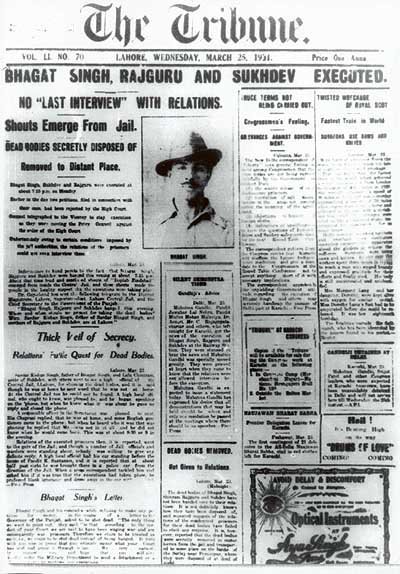
While in prison, Bhagat Singh and two others had written a letter to the Viceroy asking him to treat them as prisoners of war and hence to execute them by firing squad and not by hanging. Prannath Mehta, Bhagat Singh’s friend, visited him in the jail on 20 March, four days before his execution, with a draft letter for clemency, but he declined to sign it.
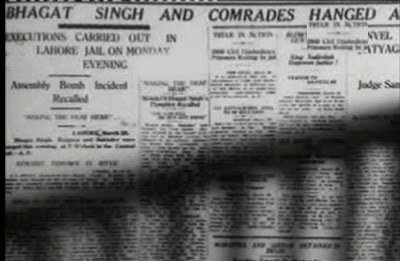
Movies on Bhagat Singh
Shaheed-e-Azad Bhagat Singh (1954)
Shaheed Bhagat Singh (1963)
Shaheed (1965)
The Legend of Bhagat Singh (2002)
23rd March 1931: Shaheed(2002)
Shaheed-E-Azam(2003)
Rang De Basanti(2006)
The 2006 film Rang De Basanti is a film drawing parallels between revolutionaries of Bhagat Singh’s era and modern Indian youth. It covers a lot of Bhagat Singh’s role in the Indian freedom struggle. The movie revolves around a group of college students and how they each play the roles of Bhagat’s friends and family.
The patriotic Urdu and Hindi songs, Sarfaroshi ki Tamanna (translated as “the desire to sacrifice”) and Mera Rang De Basanti Chola (“my light-yellow-coloured cloak”; Basanti referring to the light-yellow color of the Mustard flower grown in the Punjab and also one of the two main colours of the Sikh religion as per the Sikh rehat meryada (code of conduct of the Sikh Saint-Soldier)), while created by Ram Prasad Bismil, are largely associated to Bhagat Singh’s martyrdom and have been used in a number of Bhagat Singh-related films.
Quotes by Bhagat Singh
“The aim of life is no more to control the mind, but to develop it harmoniously; not to achieve salvation here after, but to make the best use of it here below; and not to realise truth, beauty and good only in contemplation, but also in the actual experience of daily life; social progress depends not upon the ennoblement of the few but on the enrichment of democracy; universal brotherhood can be achieved only when there is an equality of opportunity – of opportunity in the social, political and individual life.” — from Bhagat Singh’s prison diary,
“Inquilab Zindabad” (Long live the revolution)
“When I set my foot on the path of revolution, I thought if I could spread the slogan of Inquilab Zindabad to every corner of India. Today when I am behind bars, I can hear the roaring sound of that slogan. What more price could there be for so short a life?”
Original Photos of Bhagat Singh
A rare historical photograph of students and staff of National College, Lahore, which was started by Lala Lajpat Rai for education of students participating in the non-cooperation movement. Bhagat Singh can be seen standing fourth from the right.
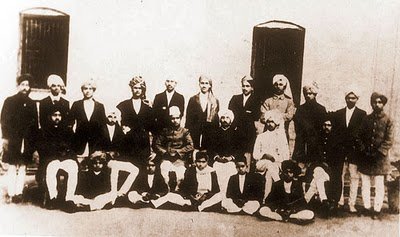


Comments 1
तकदीर लिखने वाले एक एहसान मुझ पर कर दे‚मेरे दोस्तो के नाम मुस्कान लिख दे‚
ना मिले इन्हे जिन्दगी मे कोई गम चाहे इनके हिस्से मे मेरी जान लिख दे।